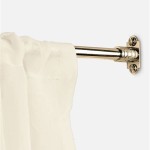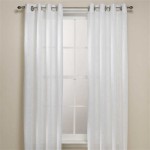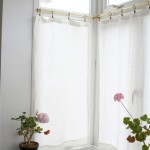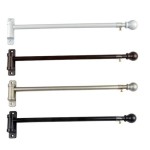Navy And White Blackout Curtains: A Comprehensive Guide
Navy and white blackout curtains represent a versatile and functional window treatment option for a variety of spaces. Combining the elegance of navy, the crispness of white, and the practicality of blackout capabilities, these curtains offer a blend of aesthetic appeal and functional benefits. The following article will delve into the key aspects of navy and white blackout curtains, exploring their aesthetic versatility, light-blocking properties, thermal regulation benefits, and maintenance considerations.
Aesthetic Versatility and Design Integration
The color combination of navy and white offers a timeless and adaptable aesthetic that can complement a wide range of interior design styles. Navy, a deep and sophisticated shade of blue, often evokes feelings of tranquility and stability. White, on the other hand, provides a sense of cleanliness, brightness, and spaciousness. When these two colors are combined in curtains, they create a balanced and visually appealing element that can enhance the overall ambiance of a room.
Navy and white blackout curtains can be found in a variety of patterns and designs. Options range from simple, solid color blocks with a navy curtain and white lining to more intricate patterns such as stripes, geometric designs, or floral prints. The choice of pattern often depends on the desired aesthetic and the existing décor of the room. For instance, a minimalist or modern room may benefit from solid navy curtains with a white blackout lining, creating a clean and understated look. A nautical-themed room might incorporate striped navy and white curtains to reinforce the theme, while a more traditional room could feature a floral print with navy and white as the dominant colors.
Furthermore, the texture of the fabric plays a significant role in the overall aesthetic. Options include cotton, linen, polyester, and blends of these materials. Heavier fabrics, such as velvet or thick cotton, tend to convey a sense of luxury and provide enhanced insulation, while lighter fabrics like linen or sheer blends can create a more airy and casual feel. The choice of fabric should consider not only the aesthetic preferences but also the functional needs of the space.
The hardware used to hang the curtains also contributes to their overall appearance. Curtain rods and rings are available in various finishes, including brushed nickel, oil-rubbed bronze, and matte black. The choice of hardware should complement the color scheme and style of the curtains and the room as a whole. For example, brushed nickel hardware might pair well with a modern, minimalist design, while oil-rubbed bronze hardware could enhance the traditional feel of a more formal space.
The placement of the curtains is another crucial aspect of design integration. Hanging the curtains high and wide, extending beyond the window frame, can create the illusion of larger windows and a more spacious room. This technique can be particularly effective in smaller rooms or rooms with low ceilings. Additionally, the length of the curtains should be carefully considered. Curtains can be hung to just touch the floor, puddle slightly, or hang at a specific predetermined length. The choice of length depends on the desired aesthetic and the functionality of the space. Curtains that puddle slightly can add a touch of elegance and drama, while curtains that just touch the floor are often more practical for high-traffic areas.
Light Blocking and Blackout Functionality
The primary function of blackout curtains is to block out external light, creating a darkened environment suitable for sleeping, watching movies, or any activity that requires a dim or dark setting. Navy and white blackout curtains achieve this through a combination of fabric density and specialized linings. The navy color itself contributes to blocking some light, as darker colors generally absorb more light than lighter colors. However, the white lining is typically the key component responsible for the blackout effect.
Blackout linings are typically made from a dense, opaque material that prevents light from passing through. This material can be a separate layer sewn onto the back of the curtain or a coating applied to the fabric. The thickness and density of the lining directly impact its light-blocking capabilities. Higher-quality blackout curtains often feature multiple layers of lining or a particularly dense coating to ensure optimal light blockage.
The effectiveness of blackout curtains also depends on the fit and installation. Gaps around the edges of the curtains can allow light to seep in, compromising their performance. To minimize light leakage, it is crucial to choose curtains that are wide enough to cover the entire window frame and extend beyond it on all sides. Using wraparound curtain rods can also help to reduce light leakage by preventing light from entering through the sides of the curtains. Additionally, consider using valances or cornices to block light from entering through the top of the curtains.
Different levels of blackout are available, ranging from light-filtering to complete blackout. Light-filtering curtains allow some light to pass through, creating a softened and diffused effect. Blackout curtains, on the other hand, aim to block out as much light as possible, typically reducing light transmission by 95% or more. The choice of blackout level depends on the specific needs and preferences of the user. For bedrooms, complete blackout curtains are often preferred to ensure a dark and restful sleep environment. For living rooms or media rooms, a slightly lower level of blackout may be sufficient, allowing some ambient light to filter through.
The type of fabric used in the curtains also affects their light-blocking capabilities. Thicker, denser fabrics naturally block more light than thinner, lighter fabrics. Therefore, combining a dark-colored, dense fabric with a blackout lining can provide the most effective light blockage. Consider fabrics such as velvet, heavy cotton, or polyester blends for optimal performance. Sheer or lightweight fabrics are not suitable for blackout curtains, as they allow too much light to pass through.
Thermal Regulation and Energy Efficiency
In addition to their light-blocking capabilities, navy and white blackout curtains offer thermal regulation benefits that can contribute to energy efficiency. The dense fabric and blackout lining act as a barrier, reducing heat transfer between the inside and outside of the room. During the summer months, blackout curtains can help to keep the room cooler by blocking out sunlight and preventing heat from entering. During the winter months, they can help to retain heat inside the room, reducing the need for heating and lowering energy costs.
The thermal insulation provided by blackout curtains can significantly impact the overall energy efficiency of a home. By reducing the amount of heat that enters or escapes through the windows, blackout curtains can help to maintain a more consistent temperature inside the room, reducing the strain on heating and cooling systems. This can lead to lower energy bills and a more comfortable living environment.
The effectiveness of blackout curtains for thermal regulation depends on several factors, including the thickness and density of the fabric, the quality of the blackout lining, and the fit and installation of the curtains. Thicker, denser fabrics with a high-quality blackout lining provide the best insulation. Ensuring a tight fit around the window frame is also crucial to prevent air leakage and maximize the thermal benefits. Using insulated curtain rods or valances can further enhance the thermal performance of the curtains.
The color of the curtains can also play a role in their thermal regulation capabilities. Darker colors tend to absorb more heat than lighter colors. Therefore, navy curtains may absorb more heat than white curtains, which can be beneficial in colder climates where retaining heat is desired. However, in warmer climates, lighter-colored curtains may be preferable to reflect sunlight and prevent the room from overheating. Combining navy and white in a pattern can balance these effects, providing a compromise between heat absorption and reflection.
Blackout curtains can be particularly effective in rooms that receive a lot of direct sunlight, such as south-facing rooms. By blocking out the sun's rays, these curtains can prevent the room from becoming excessively hot during the summer months. In addition to reducing energy costs, this can also help to protect furniture and fabrics from fading due to sun exposure. Similarly, blackout curtains can be beneficial in rooms that are poorly insulated, as they can provide an extra layer of insulation to help maintain a comfortable temperature.

Navy Blue Madison Blackout Thermal Eyelet Curtains From Next Singapore

Estelar Textiler Navy Blue And Greyish White Blackout Curtains For Bedroom

Blackout Zigzag Twill Navy Blue Curtain

Homeboutique Linen Button 100 Lined Navy White 84 In L X 40 W Blackout Single Panel Window Curtain 21t012062 The Home

Navy Blue White Leaf Pattern Drapes Blackout Curtains For Grommet Top 2p 42 W 63 L Unlined

Navy Blue Blackout Curtains 52 X 63 Inch Room Darkening Bedroom Curtain Panels

Next Blue Navy Blackout Thermal Cotton Eyelet Curtains 117wx137d Adult

Dihin Home Cartoon Navy Blue Castle Printed Blackout Grommet Window Curtain For Living Room 52x63 Inch 1 Panel

Driftaway Ombre Gradient Color Lined Blackout Thermal Insulated Grommet Window Curtain For Living Room Bedroom 2 Panels 84 L X 52 W Navy Blue To White

Blue Dark Navy Matte Velvet Blackout Thermal Curtains From Next Singapore








